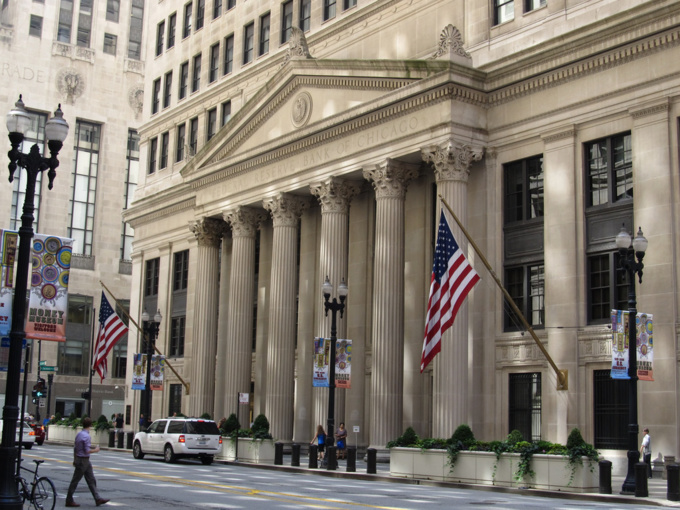According to results of a two-day meeting, the Federal Reserve Committee on US Federal Reserve raised the key rate to 2.25–2.5% per annum. In total, the rate has increased by one percentage point since the beginning of the year. The first increase took place in March, the second - in June, the third - in September. In 2017, the rate was raised three times, by a total of 0.75 percentage points.
In a statement made on Wednesday, the Fed noted the “strong pace” of improving the state of the US economy, noting separately the growth in the number of jobs and consumer activity, but also the slowdown in investment growth. The committee also pointed out that inflation, excluding food and energy, remains close to the 2% benchmark. The regulator changed the wording regarding further policy tightening and noted that only “a slight increase in rates will correspond to an improvement in the economy” (recall that in September it first abandoned the phrase that monetary policy remains stimulating). Reiterating that the risks remain relatively balanced, the committee said it would monitor the state of the global economy and financial system, as well as their impact on growth expectations.
A noticeable change happened in expectations of the majority of committee members. Now, they believe that in 2019 the rate can be increased only two, not three times, to 2.75–3% (markets also expect no more than two hikes and a possible easing of the policy after that). In 2020, the rate can be increased only once, up to 3–3.25%.
On Wednesday, the regulator also adjusted downward the forecast for US GDP growth for 2018 - from 3.1% to 3%, for 2019th - from 2.5% to 2.3%, inflation estimate - to 1.9% for both years (from 2.1% in this and 2% in the 2019th).
Growth in the United States in the third quarter was 3.5% versus 4.2% in April-June, the unemployment rate in November remained at an extremely low level - 3.7% (at the same time, fewer jobs were created during the month than in October, - 155 thousand against 250 thousand), wage growth accelerated to 3.1% - the maximum since 2009. At the same time, consumer spending inflation minus food and fuel slowed in October from 1.9% to 1.8% (data for November has not yet been published).
The growth of the American economy may slow down next year, Capital Economics expects. Another halt in the work of the US government can also have a negative effect (party representatives have still not approved the budget for the 2019 fiscal year, which began in October). "In March, a temporary agreement on raising the national debt ceiling expires, reserves will last for several months after that, but by July there may be a risk of non-payment on public debt," experts say. In turn, the risks of a slowdown in the global economy have already affected the next drop in oil prices, according to Julius Baer. In addition, trade restrictions have a negative impact on the Chinese economy, the bank notes. Recall that on the G20 margins, US President Donald Trump and Chinese President Xi Jinping agreed to abstain from introducing new duties until March 1, 2019.
source: capitaleconomics.com
In a statement made on Wednesday, the Fed noted the “strong pace” of improving the state of the US economy, noting separately the growth in the number of jobs and consumer activity, but also the slowdown in investment growth. The committee also pointed out that inflation, excluding food and energy, remains close to the 2% benchmark. The regulator changed the wording regarding further policy tightening and noted that only “a slight increase in rates will correspond to an improvement in the economy” (recall that in September it first abandoned the phrase that monetary policy remains stimulating). Reiterating that the risks remain relatively balanced, the committee said it would monitor the state of the global economy and financial system, as well as their impact on growth expectations.
A noticeable change happened in expectations of the majority of committee members. Now, they believe that in 2019 the rate can be increased only two, not three times, to 2.75–3% (markets also expect no more than two hikes and a possible easing of the policy after that). In 2020, the rate can be increased only once, up to 3–3.25%.
On Wednesday, the regulator also adjusted downward the forecast for US GDP growth for 2018 - from 3.1% to 3%, for 2019th - from 2.5% to 2.3%, inflation estimate - to 1.9% for both years (from 2.1% in this and 2% in the 2019th).
Growth in the United States in the third quarter was 3.5% versus 4.2% in April-June, the unemployment rate in November remained at an extremely low level - 3.7% (at the same time, fewer jobs were created during the month than in October, - 155 thousand against 250 thousand), wage growth accelerated to 3.1% - the maximum since 2009. At the same time, consumer spending inflation minus food and fuel slowed in October from 1.9% to 1.8% (data for November has not yet been published).
The growth of the American economy may slow down next year, Capital Economics expects. Another halt in the work of the US government can also have a negative effect (party representatives have still not approved the budget for the 2019 fiscal year, which began in October). "In March, a temporary agreement on raising the national debt ceiling expires, reserves will last for several months after that, but by July there may be a risk of non-payment on public debt," experts say. In turn, the risks of a slowdown in the global economy have already affected the next drop in oil prices, according to Julius Baer. In addition, trade restrictions have a negative impact on the Chinese economy, the bank notes. Recall that on the G20 margins, US President Donald Trump and Chinese President Xi Jinping agreed to abstain from introducing new duties until March 1, 2019.
source: capitaleconomics.com



















